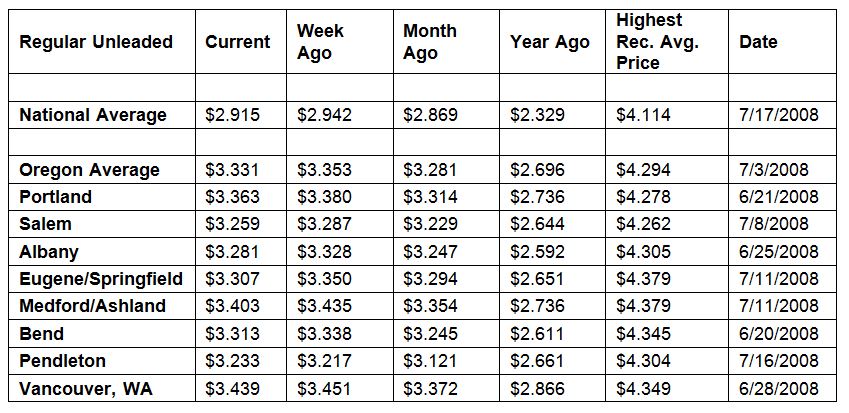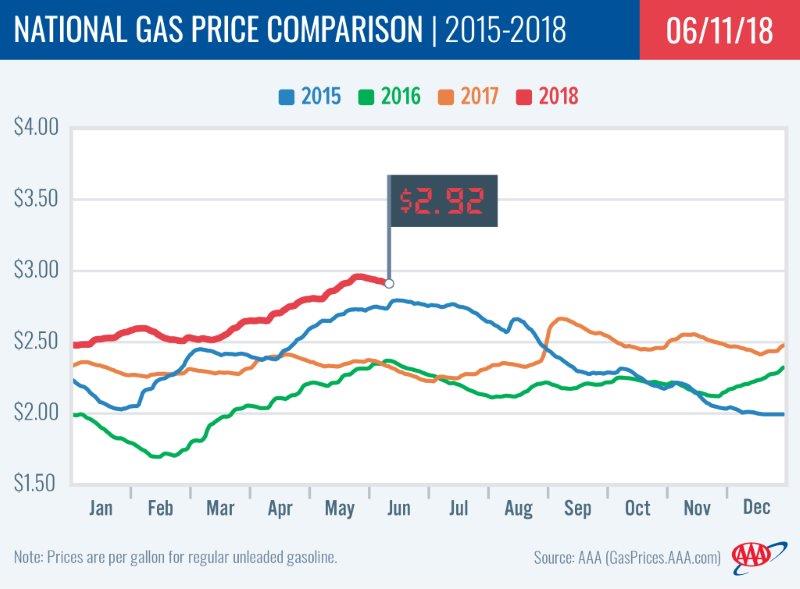PORTLAND, Ore., – Gas prices are ticking lower but still remain at least 50 cents a gallon more expensive than last summer in every state. For the week, the national average for regular dips two cents to $2.92 a gallon. The Oregon average also falls two cents to $3.33.
“The higher pump prices compared to one year ago seem to be influencing driving habits. While consumer demand remains strong, it has slowed from levels seen earlier this year,” says Marie Dodds, public affairs director for AAA Oregon/Idaho.
Dropping by 713,000 b/d, the U.S. Energy Information Administration (EIA) reports that demand registers – for the first time since mid-January – just under 9 million b/d. This is surprising, as levels have consistently measured above the 9 million mark every week in June since 2015.
Oregon is one of 42 states and the District of Columbia reporting week-over-week decreases. The largest decreases are in Indiana (-12 cents) and Illinois (-8 cents). Only eight states report weekly increases. Utah has the largest (+4 cents). This week 14 states have averages at or above $3 a gallon, down from 15 a week ago.
Oregon is one of 44 states and the District of Columbia where prices are higher than one month ago. The national average is five cents more and the Oregon average is also five cents more than a month ago. Oregon has the 26th-largest monthly increase in the country. South Dakota (+18 cents) and Montana (+18 cents) have the largest monthly gains.
The West Coast continues to have the most expensive gas prices in the nation. Hawaii bumps California out of the top spot, with Washington, Alaska and Oregon rounding out the top five. Oregon is fifth most expensive for the third week in a row.
| Rank | Region | Price on 6/12/18 | |
| 1 | Hawaii | $3.72 | |
| 2 | California | $3.72 | |
| 3 | Washington | $3.46 | |
| 4 | Alaska | $3.43 | |
| 5 | Oregon | $3.33 | |
| 6 | Nevada | $3.33 | |
| 7 | Idaho | $3.19 | |
| 8 | Utah | $3.16 | |
| 9 | Connecticut | $3.13 | |
| 10 | Arizona | $3.07 |
On the week, prices are edging slightly lower in the West Coast region. However, Arizona (+1 cent) and Alaska (+2 cents) saw increases, while Oregon (-2 cents) saw the largest decrease in the region.
According to EIA data for the week ending on June 1, inventories of gasoline in this region fell by 200,000 bbl to reach 31.1 million bbl. When compared to a year ago, levels are still up more than 3 million bbl and could contribute to price stabilization in coming weeks.
The nation’s cheapest markets are South Carolina ($2.58) and Mississippi ($2.61). For the 45th week in a row, no states have an average below $2.
Drivers in all 50 states and the District of Columbia are paying are paying more than a year ago to fill up. The national average is 59 cents more and the Oregon average is 64 cents more than a year ago. This is the 8th-largest yearly increase in the country. Arizona has the greatest year-over-year increase of 77 cents; New Mexico is second at 70 cents; and California is third at 68 cents.
Oil Market Dynamics
It’s been a volatile few weeks for crude oil prices. Three weeks ago, crude oil prices were at three-and-a-half year highs of about $73 per barrel. Then crude prices tumbled in late May after reports that OPEC might ease its production cuts. Since then, prices have remained below $70.
Oil prices trended marginally lower last week following EIA’s report that crude production hit 10.8 million b/d last week. The estimate sets another weekly domestic record, which has been a reoccurring phenomenon in 2018. When compared to last year at this time, the U.S. is producing roughly 1.5 million b/d more this year.
Crude prices will continue their roller coaster ride in the near future. Contributing factors include reports that OPEC may not announce an increase in crude production at the next OPEC meeting scheduled for June 22 in Vienna, Austria. Prior to Memorial Day reports speculated that OPEC would increase production, which contributed to oil prices going down. In addition, economic turmoil in Venezuela has reduced the major global crude supplier’s production rates at a time when global supply is already shrinking.
Additionally, Baker Hughes, Inc. reported that the U.S. added one oil rig last week, bringing the total to 862. The total is up by 121 rigs when compared to last year at this time.
At the close of Friday’s formal trading session on the NYMEX, WTI decreased 21 cents to settle at $65.74. At the close of Monday’s formal trading session on the NYMEX, WTI added 54 cents to settle at $66.10. Today crude is trading around $67, compared to $66 a week ago. Crude prices are down about seven percent in the last month and are about $20 more per barrel than a year ago.
Drivers can find current gas prices along their route with the free AAA Mobile app for iPhone, iPad and Android. The app can also be used to map a route, find discounts, book a hotel and access AAA roadside assistance. Learn more at AAA.com/mobile.
Diesel
For the week, the national average slips a penny to $3.20 a gallon. Oregon’s average holds steady at $3.43. A year ago the national average for diesel was $2.49 and the Oregon average was $2.67.
Find current fuel prices at GasPrices.AAA.com.
AAA news releases, high resolution images, broadcast-quality video, fact sheets and podcasts are available on the AAA NewsRoom at NewsRoom.AAA.com.



